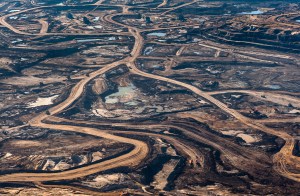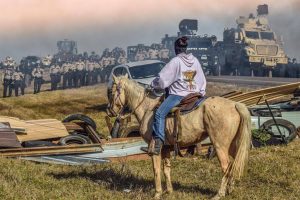Climate Justice And The Kinder Morgan Pipeline: Is This The Next Standing Rock?

Above Photo: From climatejusticeproject.org
May 2018. “Standing Rock is everywhere now.” We heard this refrain time and again in the days and weeks that followed the violent defeat and eviction of Standing Rock’s Water Protectors at the Oceti Sakowin camp on the banks of the Cannon Ball River in February last year. And it is true – despite their ultimate defeat, Standing Rock’s Water Protectors have inspired or reinvigorated uprisings against the colonial and extractivist fossil fuel industry (and its enablers in government) across North America. Standing Rock’s legacy lives in the imaginaries of the thousands of people who stood together against the Dakota Access Pipeline and the hundreds of thousands who supported them. The Water Protector’s intervention in the politics of climate change, energy and Indigenous sovereignty has instigated a paradigmatic shift in our movement’s efforts to confront the climate crisis and to dismantle entrenched systems of oppression as we do so. Since then, pipeline fights from the Bayou Bridge to the back-from-the-dead Keystone XL, to Enbridge Line 3, have all invoked Standing Rock’s powerful intervention. I am writing from another of these frontlines: the struggle against the $7.4bn Kinder Morgan TransMountain Pipeline Expansion in British Columbia. As I’m writing I’m asking myself, is Standing Rock here too?

The Burrard Inlet, Coast Salish Territory. Author’s photo
The last time I was reporting home from the frontlines of the movement to keep fossil fuels in the ground, I had joined the Water Protectors in North Dakota at the Standing Rock Sioux reservation in September 2016. On a very personal level, I was then in the midst of what I would later realize were fundamental re-evaluations that have since defined my thoughts on social movements, strategy, theory and practice. Today, I’m writing from a frontline that predates Standing Rock and yet now draws inspiration from it. I am spending a month in Coast Salish Territory on the unceded land of the Tsleil-Waututh Nation in what is now called British Columbia. I have rented a room in Burnaby, a city adjacent to Vancouver and through which the oil company, Kinder Morgan, intends to build its TransMountain Expansion pipeline. I am here to learn more about the theory and praxis of climate justice and to test some thoughts I’ve been having about social movement strategy since my time at Standing Rock. I am determined to carry out my research in a way that is as reciprocal as possible and that rejects, to the extent possible, the sometimes extractivist nature of academic field research. Drawing on insights from Participant Action Research and feminist research methods, I am working on a methodology that gives back as much as I inevitably take, but that also allows me to learn about movement strategy in a way that is situated in my own positionality as well as with rigor, accountability, and integrity. I am trying to support this struggle while learning from it. To do so I spend a lot of time volunteering, participating in actions, donating supplies, and bearing witness – so I am spending a month combining movement participation with conscious study and reflection.

Proposed route of the Kinder Morgan Trans Mountain Pipeline Extension. Image Credit: The Times Colonist
The pipeline, proposed in 2013 and approved by the Trudeau government in 2016, would triple the export capacity of diluted bitumen from Alberta’s tar sands to the Pacific coast. It is justified in terms of “critical infrastructure” and being “in the national interest” because it would finally help Canada break out of dependency on the US market to sell its vast reserves of tar sands oil. Since its initial proposal, the pipeline has been subject to profound opposition from many First Nations across whose unceded territories it traverses, as well as from residents of Burnaby and Vancouver. Crucially, the pipeline does not have the consent of the Tsleil-Waututh Nation whose territory encompasses Burnaby Mountain where the pipeline terminates at Kinder Morgan’s storage tank farm and export terminal. The pipeline twins Kinder Morgan’s first tar sands pipeline which was built in the 1950s, also without the consent of First Nations, at a time when First Nations peoples were not allowed access to lawyers to contest any project construction on their traditional lands.The local fire department has said publicly that the tank farm’s proximity to residents and forests is an unacceptable fire hazard, while the risk of oil spills from a seven fold increase in supertanker traffic through the Burrard Inlet threatens lives and livelihoods along the coast of the Pacific Northwest. These risks are born first and foremost by the residents of Burnaby and the Tsleil-Waututh, Squamish, Musqueam, and Secwepemc First Nations, while the benefits are overwhelmingly accrued to Kinder Morgan, the Albertan government, and the oil companies it represents.

Risks also impact the primarily Indigenous communities across the length of the pipeline route, particularly with regards to the construction of “man camps” associated with increased sexual violence and the development of oil infrastructure. Members of the Secwepemc Nation and the Tiny House Warriors in Southeast BC are building “Tiny Homes” in the pipeline’s path to protect their communities from the threats associated with man camps and tar sands. For all these reasons the pipeline is a flagrant example of environmental injustice.
It is also an example of climate injustice. Tar sands are the most extreme and polluting form of fossil fuel extraction. They constitute Canada’s fastest growing source of carbon emissions and, if fully operationalized, would blow Canada’s emissions reduction targets into the realm of impossible fantasy. They are, as Bill McKibben puts it, one of North America’s most dangerous “Carbon Bombs.” Tar sands reserves constitute between 7 and 16% of the world’s carbon budget. As former NASA climatologist James Hansen states bluntly, extracting and burning all of Canada’s tar sands would spell “game over” for the climate. Despite Justin Trudeau’s assertions to the contrary, there is no way that extracting oil from Alberta’s tar sands can align with Canada’s commitment to the Paris Climate Agreement. Meanwhile, the Alberta and Canada’s federal government claim that tar sands pipelines are crucial to selling their oil at a higher price in the much coveted “Asian markets.”

The Alberta Tar Sands from which Kinder Morgan’s pipeline would transport diluted bitumen. Photo credit: Garth Lenz
However, thanks in large part to mounting opposition to tar sands, as well as legal rulings and wavering shareholder confidence, transportation routes by rail and pipeline from the tar sands to export terminals have been shut down or delayed one after the other. This means that oil companies in the United States are the only major buyer of tar sands oil and import that oil at a discount. If transportation routes to foreign markets cannot be established, the tar sands can’t expand. Thus delaying, blockading, and shutting down midstream and downstream oil infrastructure has become a critical strategy for the movement to keep tar sands in the ground. For at least the passed 10 years, all major proposed pipeline routes have either been rejected, abandoned, or remain significantly delayed.
For the past few months I have been following the struggle over the Kinder Morgan Pipeline from afar as it has developed into a nation-wide crisis. Amidst sustained direct action, mounting legal suits, the opposition of the incumbent New Democratic Party in BC (the NDP is sustained through an alliance with the Green Party in the provincial government), wavering shareholder confidence, and quite possibly its own realization that the pipeline is unviable, Kinder Morgan announced on April 8th 2018 that it would suspend all non-essential spending on the project until May 31st 2018 – by which time it will decide whether to cancel the pipeline altogether. What at first seemed, and to a certain extent is, an important victory for the pipeline’s opponents, is also an ultimatum. The company has basically said to the Canadian government “this is your problem now, sort it out or we’re leaving.” Rachel Notley, Alberta’s premier (also of the NDP), and the Trudeau government, want this pipeline badly. Indeed, at this point, both leaders seem to have staked their political careers on getting the pipeline built and have pledged financial and political support to shore up investor confidence and mitigate uncertainty around the projects future. The federal government has promised to indemnify shareholder risk with financial assistance from the government, or rather taxpayers. An amount has not yet been established but it could rise to a possible $10 billion bailout along with millions of dollars in subsidies should the pipeline project fail due to continued political contestation. Meanwhile, the provincial and federal politicking have put enormous strain on Canada’s federal system, with questions of provincial jurisdiction and First Nations Sovereignty in the balance. The extent to which these questions may be resolved will likely play out in Canada’s highest courts, with legal strategy playing a pivotal role in the confrontation.
It is in this context then, that I arrived in Coast Salish territory two weeks ago. Through conversations with many land and water protectors here on the ground, I have found that this struggle is being fought on several terrains. First, and currently the most significant is the legal battle. Members of the Tsleil-Waututh, Squamish, and Musqueam Nations, Environmental NGOs, the provincial government, and local municipal governments have all filed cases to have the pipeline’s approval overturned. The trials have been conducted and a decision is likely in the next few weeks. Meanwhile, these cases have been bolstered with new evidence suggesting that the Trudeau government did not enter into consultations with First Nations peoples in good faith. While many had presumed as much, investigation by the National Observer showed that Cabinet officials told staff to find reasons to legally approve the pipeline before the consultations were finished. This has cemented the belief amongst many pipeline opponents that the approval process was rigged in favor of Kinder Morgan.

Respect UNDRIP banner. Author’s photo
Under Canadian law, First Nations must be consulted about projects that would impact their traditional territories. Moreover, the United Nations Declaration on the Rights of Indigenous Peoples (UNDRIP) states that all projects on Indigenous lands must have the free, prior, and informed consent of Indigenous peoples living there. Another tar sands pipeline, Enbridge’s Northern Gateway, was rejected by the courts, and ultimately Prime Minister Trudeau, because of inadequate consultation with First Nations.
The second terrain of struggle revolves around policy and provincial politics. British Columbia’s NDP premier, John Horgan, introduced legislation in January 2018 that would place a moratorium on the transportation of diluted bitumen through the province until more is known about how the substance interacts with water in the event of an oil spill. This policy would have stopped Kinder Morgan’s pipeline in its tracks, delaying the project indefinitely and scaring away investors. It is also unclear whether the province has legal jurisdiction over regulating interprovincial oil transportation and, inevitably, it enraged both Alberta and the Federal government. The policy has since been referred to the courts for a judge to decide whether such jurisdiction would in fact be legal – the ensuing delay is one reason Kinder Morgan has announced its ultimatum. In retaliation, Alberta’s Rachel Notley floated the idea of an embargo on British Columbian wine, as well as introducing legislation to give her government the power to restrict fuel supplies to British Columbia from Alberta. Some local organizations have begun lobbying Liberal members of parliament in swing seats dependent on progressive votes to reject legislation mandating a government bailout of the company should Trudeau introduce it to parliament. The question of legal jurisdiction and the very public controversy between the federal government and those of Alberta and BC have garnered the most media attention, while questions of climate justice and Indigenous sovereignty tend to be tacked on to the end of media reports, if at all. The public story, therefore, is one of “special interests,” and embattled, possibly incompetent, politicians rather than grassroots struggle against an oppressive neo-colonial legal system and an American multi-billion dollar oil company.
Thus the third terrain, and intimately linked to all the others, is what Reinsborough and Canning call “the battle of the story.” This is the struggle over which narrative and frames are accepted as common sense – in other words, the struggle for hearts and minds. If cursory media analysis and polling data are anything to go by, it appears that Kinder Morgan and Trudeau are winning the battle of the story. While very few are enthusiastic about a government bail out of the company, well over half of the Canadian population supports the construction of the pipeline. My immediate analysis of this is that protest in general tends to be unpopular, particularly in relatively hostile media environments, and that the framing of the issue outside of Vancouver and Burnaby has emphasized the pipeline’s contribution to tax revenue and jobs, as well as the image of a selfish British Columbia overstepping its legal jurisdiction and politicians fumbling with important decisions over “the national interest.” Despite attempts of the Union of British Columbian Indian Chiefs along with local eNGOs and grassroots campaigns to frame the issue in terms of protecting the land and water, climate justice, First Nations’ Rights, and the devastating impact an oil spill would have on the local economy, the issue has largely been framed on Trudeau and Kinder Morgan’s terms. Moreover, the assertion of First Nations’ right to free prior and informed consent has been somewhat undermined by fractured and complex politics within and between different First Nations, with some signing benefit agreements with the pipeline company and others publicly endorsing its construction.
The fourth terrain is finance. Kinder Morgan’s greatest vulnerability is shareholder confidence. If shareholders start to move their money and the Canadian government doesn’t provide more funding, the pipeline project will be financially untenable – in fact there is some suggestion that it already is. The company itself cited protecting its shareholders as their primary reason for pausing pipeline construction.

Climate Convergence’s “don’t bank on it” badges. Author’s photo.
Meanwhile, pipeline opponents have deployed tactics designed to shake shareholder confidence or otherwise suggest the project is unviable. These include forms of protest like shareholder activism and divestment that challenge the company’s social license to operate, as well as maintaining a barrage of blockades and work stoppage outside Kinder Morgan’s Burnaby facilities. On Saturday local organizations organized a rally and march outside TD Bank headquarters and several of the pipeline’s other most significant investors. As an example secondary targeting, the event drew attention to the capital flows and investment partnerships upon which the company depends to remain operative. Land and water protectors rallied around the slogan “don’t bank on it!” to highlight the pipeline’s current financial vulnerability.

Don’t Bank On It March and Rally. Photo credit: Doug Sprenger
I have started working with local community organizations on planning events and actions to challenge Kinder Morgan’s perceived legitimacy and draw attention to the lengths to which the community is prepared to go to stop the pipeline. Here I’ve seen that the fifth terrain of struggle is non-violent direct action which, so far, plays an important symbolic role in maintaining the image of dissent and intervening in the narrative. Last Wednesday, for example, I participated in an action with around 60 other water and land protectors to shut down the Kinder Morgan export terminal, coinciding with the company’s Annual General Meeting with shareholders and to stand in solidarity with members of Tsleil-Waututh and Secwepemc First Nations who spoke to investors at the AGM. Blocking the gates from both land and sea, the direct action participants drew attention to their narrative while forcing a work stoppage for the day. This Wednesday I participated in a die-in, blockading the tank farm gates and drawing attention the fire hazards associated with the expansion project. Both actions drew large crowds, particularly for weekday mornings, and attracted media attention to the protectors reframing of the story. I have spent most my time over the past couple of weeks volunteering with camp maintenance at the Protect the Inlet campsite where some members of the Tsleil-Waututh Nation and their allies have built a spiritual Watch House directly on top of the pipeline route and overlooking Kinder Morgan’s activities. Consisting of about a dozen regular members and a couple of dozen more weekly visitors, the camp welcomes all allies but is Indigenous-Led and subject to Tsleil-Waututh protocols of acting in peace and prayer. The camp seems intended to focus the struggle against Kinder Morgan around Indigenous sovereignty, protection, and resistance. Along with Camp Cloud, just outside Kinder Morgan’s tank farm, this seems to be the hub of the campaign’s civil disobedience component, with weekly and biweekly protests, arrests, “Bold Action,” and ceremonies outside Kinder Morgan’s gates. The camp remains small for now but has the potential to grow should the conflict escalate.

The Watch House: Kwekwecnewtxw (A place to watch from). Photo source: Protect the Inlet
The broader impacts of civil disobedience and direct action tactics deployed so far are somewhat unclear. However, the actions themselves are strategic, well planned, and highly orchestrated with the help of a team of experienced campaign leaders. Kinder Morgan has been granted an injunction zone of 5 meters surrounding the perimeter of their property. Those violating the injunction zone may be found guilty of contempt of court. Around 200 people have been arrested participating in civil disobedience since the campsite was erected on March 10th. Police presence and arrests tends to be very carefully managed by organizers and civil disobedience trainings are mandatory to ensure situations do not escalate. Moreover, while still engaging in highly intrusive surveillance practices, the police themselves seem to have been instructed to be on their best behavior with regards to treatment of the blockades. I imagine they fear bad press for law enforcement might cede moral high ground to the pipeline opposition and both the Canadian government and Kinder Morgan seem to be very wary of this. There is also, of course, a racialized component of police tactics. As one of the camp’s spiritual leaders often reminds participants, if it were just Indigenous folks blocking the gates we could probably expect more heavy-handed and repressive policing. In what is clearly an intimidation tactic, and following Kinder Morgan’s request, the judge trying arrestees who have taken Bold Action has increased charges from a civil contempt of court to criminal contempt. Those participating in direct action comprise a variety of Indigenous and non-Indigenous peoples including faith leaders, students, politicians, and community members. Civil disobedience has so far performed a symbolic function aimed at delegitimizing the pipeline and drawing attention to the questions of justice and sovereignty currently missing from the mainstream media narrative. Whether non-violent direct action and forcing a crisis of legitimacy will play a more central role in the campaign, along with an escalation of non-violent tactics, will likely depend on the results of court cases still in play, and crucially the decisions made on May 31st.

Kinder Morgan’s Burnaby export terminal shut down. Author’s photo
So the question remains, is this fight the next Standing Rock? I think the answer is both yes and no. Standing Rock was certainly about Indigenous sovereignty, climate justice, protecting the land and water, and fundamentally rethinking our relationship with energy, and so too is the fight with Kinder Morgan. Moreover, people on the frontlines of the fight against Kinder Morgan are certainly taking inspiration from the uprising and are in communication with Standing Rock’s leaders. But there, I think, the overt similarities end. The shifting political and economic contexts of colonialism and extractivism in British Columbia and Canada are qualitatively different from those of North Dakota and the United States. This means that, while they will inevitably share some characteristics, the strategies and tactics deployed to oppose pipeline construction and bring about a just transition must be quite different too.
Let’s take, for example, the question of consent. The Trudeau government is determined to prove that pipelines and fossil fuel infrastructure can be built “the Liberal way,” i.e. they are supposedly passed after a lengthy approval process, are subject to environmental review and conditions, they align with Canada’s climate targets, they benefit communities that host the infrastructure, and First Nations are adequately consulted about construction. As professor George Hoberg explained to me, the former Conservative prime minister, Stephen Harper, took a different approach. He attempted to force pipelines through while criminalizing dissent and ignoring the issue of consent. This, according to the Liberals, cost him a pipeline when a Supreme Court judge ruled against the Northern Gateway pipeline because of failure to adequately consult with First Nations. While Glen Coulthard critiques it for very good reasons, the Liberal government’s strategic pivot towards a rights and recognition based approach to pipeline-building has opened up strategic avenues for counter tactics that were not available to Standing Rock’s Water Protectors. Thus battles in the courts currently play a much more significant role here than in North Dakota. The fast tracking of the permits for the Dakota Access Pipeline and rerouting the pipeline away from Bismarck’s whiter, more affluent, community was also a significant difference – this gave Water Protectors less time to organize alliances and divided communities but also provided more evidence of the injustices of colonialist extractivism to the public. Meanwhile, Kinder Morgan’s pipeline has been subject to lengthy bureaucratic process which means the alliances being forged against Kinder Morgan have had more time to coordinate, are more deliberately organized, and have engaged a more diverse range of actors. They are, however, not nearly as far-reaching in terms of numbers of engaged supporters.
The Liberals’ philosophy influences the policing of dissent too. Wary of the images of violence and police brutality used against non-violent civil disobedience that can force a crisis of legitimacy, the Liberal approach to protest seeks to deescalate events, to “squash the drama,” as 350.org strategist Cam Fenton puts it, while maintaining more insidious modes of policing. This makes it harder for those engaging in direct action to force a moral crisis and reframe the issue. At Standing Rock the viral and now iconic images of police brutality and militarization served to prove the Water Protectors’ point and rallied enormous support for their cause. In this way the Water Protectors could frame and win the battle of the story by claiming the moral high ground under the rallying cry “Mni Wiconi” or “Water is Life.” Such an opportunity for escalation and reframing has not yet availed itself to the Kinder Morgan opposition and, while the major fight remains in the courts, may not yet be strategic anyway.

Militarized response to Standing Rock. Photo credit: Red Hawk, Standing Rock Rising
The matter is further differentiated from Standing Rock in so far as grassroots campaigns and eNGOs have key allies in local and provincial government. This seems to have been a mixed blessing. On the one hand, it has mobilized enormous resources against Kinder Morgan and has certainly helped delay the pipeline’s construction. On the other, it has meant that the story is largely framed around the activities of the BC government rather than climate justice and First Nations’ sovereignty. Additionally, the coalition of leaders formed around opposition to Kinder Morgan is far more diverse than the leadership on the ground at Standing Rock. Standing Rock was an Indigenous-led uprising, and while this campaign depends upon Indigenous leadership too, more mainstream eNGOs and grassroots community organizations in Burnaby and Vancouver are also playing leading roles. Furthermore, while Indigenous communities at Standing Rock were, for the most part, able to put aside many longstanding differences to fight collectively for sovereignty and to protect the water, the question of First Nations’ sovereignty and consent is somewhat more complicated in this conflict. Some First Nations actively support the pipeline and want to see its benefits help fund their communities and movements for autonomy, others feel compelled to sign benefits agreements out of resignation to what they may see as the inevitability of the pipeline’s construction. Moreover, internal to First Nations, just like any other community, members do not speak with one voice – some band councils may support the pipeline while some of the Indigenous peoples they represent may not. Leaving aside the incredible complexity of this issue, this diversity of First Nations’ orientations towards oil sands and pipeline building (perceived or otherwise) has been used by Kinder Morgan and the Trudeau government as a divide and conquer strategy to suggest they actually do have consent for the pipeline. This would not have been as compelling a case at Standing Rock but it has some purchase here.
Despite its possible implications for the constitution of the Canadian Federation and despite the duration and stakes of the struggle, the issue has not yet become mainstream in public consciousness in any consistent way. While the media blackout in the early days of the Standing Rock uprising may actually have helped the campaign, allowing communications teams to develop their narrative, pique audiences’ interest, and then explode onto social media with livestreams and viral hashtags, a steady trickle of opinion pieces and news, along with the occasional front page headline, keep the confrontation with Kinder Morgan on the political backburner but only occasionally advance it to the forefront of political discourse. This is perhaps nowhere clearer than in the fact that when I tell people I’m writing part of my dissertation on the Kinder Morgan pipeline they haven’t got a clue what I’m talking about but when I mention Standing Rock everyone immediately recognizes the name. Cam Fenton writes that the pipeline fight can’t just be about the pipeline, it has to be a lightning rod, a flashpoint that is symbolic of the broader struggle for keeping fossil fuels in the ground, climate justice, First Nations’ sovereignty, and clean water. For most observers of the struggle, these are not the immediate frames Kinder Morgan’s pipeline brings to mind. It seems to me that, so far, the fight against Kinder Morgan hasn’t achieved this status or this degree of recognition beyond the usual suspects of climate justice activists and the most impacted communities. I think it must become such a flashpoint of recognition if the fight is to be won after May 31st.
To finish up, while some people I’ve spoken to believe that the pipeline project will most likely die a series of slow and quiet deaths at the hands of backroom bureaucracy, it seems to me that if, on May 31st Kinder Morgan decides it has enough investor confidence and federal support to continue the pipeline project, regardless of court case outcomes, then it is incredibly unlikely that any party involved will back down without a serious fight. Each side has committed too much at this point to lose face. This has serious consequences for Canada’s status as a confederation and so an escalation of the conflict through the summer may be inevitable. The Liberal strategy may change, policing may intensify and Trudeau may even consider deploying the military to “hold the nation together.” The success of the opposition’s escalation will depend not only upon the extent to which they can legitimize their continued resistance within broader public discourse but also the resilience of movement coalitions, their access to resources, and their ability to withstand increasingly repressive measures. Such a crisis may provide the symbolic flashpoint the campaign needs to win, but it may also consist of a brutal and highly efficient campaign of repression in the name of “national interest” backed by the majority of Canadians. But, as most people have been saying to me so far, at this point, “who knows?”

The Union of British Columbian Indian Chiefs lead a march of thousands. Photo credit: Darryl Dyck / The Canadian Press
Finally, while Standing Rock was an incredible intervention in the US political landscape and has done more to galvanize the “keep it in the ground” movement than perhaps any other campaign in North America, the pipeline was completed and oil now flows beneath the Missouri River. The Water Protectors very successfully forced a crisis of legitimacy on the fossil fuel industry and the colonial power relations upon which it rests, and they also built resilient alliances across cultures and nations, but they were ultimately defeated due to an overwhelming militarized response invigorated by the election of President Trump. Certainly our campaigns should be seeking to emulate the relevance, size, and impact that Standing Rock’s Water Protectors achieved, but we must also ask do we want another Standing Rock? Or rather, what can we learn from Standing Rock’s defeat to prepare ourselves in different political contexts for more successful struggles against fossil fuel companies and their political enablers? The next Standing Rock probably won’t look like Standing Rock, it will have learned and adapted from Standing Rock successes and failures and will be contextualized in a different political landscape. If May 31st does not resolve the conflict, I think that’s what we might be about to see here in Coast Salish Territory.
Theo LeQuesne, May 16th 2018
*-*-*-*
If you are moved to and are able please consider donating to one of the following…
The Stop the Kinder Morgan Legal Defense Fund: https://stopkmlegalfund.org
The Maintenance of the Watch House and the Protect the Inlet Camp: https://protecttheinlet.ca/asp-products/donations/
The Tsleil-Waututh Sacred Trust to defeat Kinder Morgan: https://twnsacredtrust.ca/what-you-can-do/
The Tiny House Warriors building tiny, sustainable homes in the path of the pipeline: http://tinyhousewarriors.com
Or you can buy t-shirts or hoodies here with proceeds going towards efforts to stop the pipeline: https://www.coastprotectors.ca/swag
You can also support by drawing attention to the fight. If your bank is invested in the Kinder Morgan you can help organize a rally outside their local bank branch. Call on them to divest from Kinder Morgan or move your money somewhere else. See a list of the pipeline’s major investors here: https://www.nationalobserver.com/2017/07/21/analysis/whos-banking-kinder-morgans-trans-mountain-pipeline
If you have a pension, chances are your pension fund is invested in the pipeline company. Find out whether it is and see whether you can urge your fund manager to publicly divest from Kinder Morgan.
Source Article from https://popularresistance.org/climate-justice-and-the-kinder-morgan-pipeline-is-this-the-next-standing-rock/
Related posts:
Views: 0
 RSS Feed
RSS Feed

















 May 24th, 2018
May 24th, 2018  Awake Goy
Awake Goy  Posted in
Posted in  Tags:
Tags: 
















